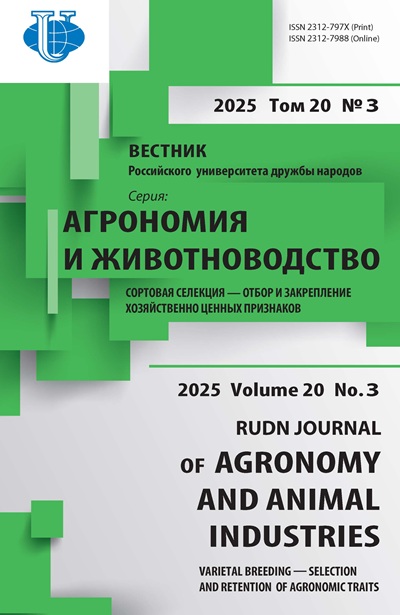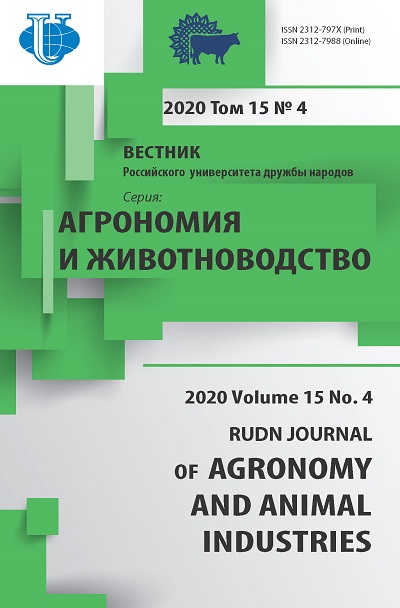Том 15, № 4 (2020)
- Год: 2020
- Статей: 8
- URL: https://agrojournal.rudn.ru/agronomy/issue/view/1114
- DOI: https://doi.org/10.22363/2312-797X-2020-15-4
Весь выпуск
Растениеводство
Изучение особенностей водного режима и пылеудерживающей способности культур Betula pendula Roth. в Северном Казахстане
Аннотация
Цель исследований - определение водного режима и выявление характера пылеудерживающей способности ассимиляционного аппарата искусственных березовых насаждений в зеленой зоне г. Нур-Султана (Северный Казахстан). Объект исследований - 16-летние лесные культуры Betula pendula Roth., часть которых была пересажена в 8-летнем возрасте в межкулисное пространство. Рассмотрены некоторые особенности водного режима лесных культур для определения адаптационной способности к почвенно-климатическим условиям произрастания. Изучены интенсивность транспирации листьев, относительное содержание воды в листьях, уровень водного дефицита. При выполнении наблюдений установлено, что на пробных площадях в пересаженных и непересаженных культурах нет достоверного различия между показателями водного режима, поэтому результаты исследований приведены без учета особенностей места закладки пробных площадей. Выявлена высокая водоудерживающая способность листьев рассматриваемых культур, которая составила 96,98 %. Интенсивность транспирации в среднем за вегетационный период была в пределах 176 мг/г∙ч, при этом наибольший средний показатель интенсивности транспирации (229 мг/г∙ч) выявлен в июле, наименьший - в августе (162 мг/г ∙ ч). Сделан вывод о слабой интенсивности испарения влаги листьями, что говорит о низком водном дефиците рассматриваемых культур, который составил 8,96 % при полном насыщении листа влагой. При определении соотношения осевшей пыли и площади листьев березы повислой установлено, что на единицу площади ассимиляционного аппарата (1 см2) в среднем по пробным площадям оседает 0,1 мг пыли. При определении количества осевшей пыли выявлено, что на высоком местоположении на единицу площади ассимиляционного аппарата оседает пыли больше, чем на низком. Наибольшее количество пыли (0,117 мг/см2) осаживалось на отдаленности в 1000 м от автомагистрали, наименьшее (0,091 мг/см2) - на расстоянии 200 м. На данный факт повлияли особенности рельефа местности и наличие защитной полосы перед культурами березы. При проведении исследований установлено, что большая площадь листа не является гарантией лучшей пылеудерживающей способности.
 325-334
325-334


Влияние способов основной обработки почвы на урожайность и качество зеленой массы сортов озимого рапса
Аннотация
Разработка рациональной системы основной обработки почвы является гарантом формирования сельскохозяйственными культурами достаточно высоких урожаев. Для решения этих вопросов при возделывании сортов озимого рапса на светло-каштановых почвах Приморско-Каспийской подпровинции Республики Дагестан были проведены исследования в двухфакторном полевом опыте. В качестве объекта изучены сорта озимого рапса ВЭМ (стандарт), Элвис и Метеор. Изучены следующие способы обработки почвы: отвальная (контроль), безотвальная. В ходе проведенных исследований выявлено, что между вариантами обработки почвы не зафиксировано особой существенной разницы по агрофизическим показателям. Данные по засоренности посевов озимого рапса показали, что в случае применения безотвальной обработки почвы количество сорняков и их масса значительно увеличились. В фазу бутонизации количество сорняков было выше, чем на контроле (отвальная обработка) в 2,1 раза, а масса сорняков - в 1,88 раза. Во время цветения эти показатели были выше в 2,2 раза. Максимальные урожайные данные на всех вариантах опыта сформировал сорт Элвис - соответственно 44,9 и 41,4 т/га, что больше ВЭМ (стандарт) и сорта Метеор соответственно на 20,4 т/га (7,9 %) и 20,0 т/га (8,7 %). Урожайность сорта Метеор на этих вариантах также была высокой и составила 41,6 и 38,1 т/га. Прибавка по отношению к стандарту составила 11,5 и 10,4 %. Наибольшую прибавку зеленой массы обеспечила отвальная обработка почвы. В среднем по сортам по сравнению с безотвальной обработкой урожайность повысилась на 8,7 %. Наиболее высокие качественные показатели сформировал сорт Элвис, на второй позиции находится сорт Метеор.
 335-342
335-342


Продуктивность сортов сои при различных режимах орошения
Аннотация
Площади посева сои в мире ежегодно увеличиваются на 3 млн га и обеспечивают получение средней урожайности 2,7 т/га. Значительный рост отечественного соепроизводства сдерживается усилением аридизации климата, снижающейся урожайностью по стране до 1,5 т/га. Важным фактором интенсификации производства сои является расширение ее посевов в условиях орошения, где внедрение адаптированных и высокопродуктивных сортов региональной селекции, сопровождаемое улучшением водопотребления растений, способствует увеличению уровня урожайности до 3…4 т/га зерна. Объектом исследований являются разноспелые сорта сои селекции Всероссийского научно-исследовательского института орошаемого земледелия (ФГБНУ ВНИИОЗ), допущенные в сельскохозяйственное производство Нижнего Поволжья: ВНИИОЗ 86 (с 2002 г.), ВНИИОЗ 31 (с 2011 г.), Волгоградка 2 (с 2020 г.). Исследования проводили в ФГУП «Орошаемое» ФГБНУ ВНИИОЗ в 2013-2015 гг. Опыт включал два фактора: фактор А - сорта, фактор В - режим орошения с вариантами 70-80-70 % НВ (70 % в период «посев - конец бутонизации» и в период созревания 80 % НВ - цветение - налив бобов), 80-80-70 % НВ и 80-80-80 % НВ - контроль. Делянки 1-го (600 м2) и 2-го (200 м2) порядка были посеяны в 4-кратной повторности в середине мая широкорядным способом (0,7 м) с планируемой урожайностью сортов 2,5…3,5 т/га (N90P90K60 д. в./га). Сорта сои отличались особенностями формирования структуры урожая. Применение дифференцированного по фазам развития растений режима орошения сопровождались более экономным водопотреблением растений по сравнению с постоянным режимом, что способствовало росту урожайности. Самые высокие уровни урожайности за годы исследований были сформированы посевами сорта Волгоградка 2 (2,87…3,23) и ВНИИОЗ 31 (2,82…3,19), что существенно выше, чем у раннего сорта ВНИИОЗ 86 (2,17…2,51 т/га). Переменный режим орошения приводил к росту урожайности у всех сортов сои, особенно у Волгоградки 2 - на 0,31…0,36 т/га, или на 10,8…12,5 %, к контролю, благодаря повышению доли зерна в общей биомассе до 30,9…36,2 % в сравнении с контролем - 26,6…27,5 %. Наиболее значительный объем послеуборочных растительных остатков (стеблей, листьев и корней) остается в поле после уборки сортов Волгоградка 2 (6,39…7,63 т/га) и ВНИИОЗ 31, хорошо улучшающих почвенное плодородие (6,73…7,9 т/га), и наименьший объем - после раннего сорта ВНИИОЗ 86 (4,41…5,66 т/га). Дифференциация режима орошения приводила к уменьшению поступления вегетатив- ной массы в почву - 4,41…7,42 т/га по сравнению с контролем 5,66…7,9 т/га. Таким образом, лучшими сортами для орошаемого земледелия Нижнего Поволжья являются скороспелый новый сорт Волгоградка 2 и среднескороспелый ВНИИОЗ 31, обеспечивающие при дифференцированном (сравнительно экономном) режиме орошения получение высокой урожайности и улучшающие почвенное плодородие за счет поступления высоких объемов биомассы в почву после уборки.
 343-352
343-352


Защита растений
Диагностика стеблевой нематоды картофеля Ditylenchus destructor с использованием PCR-RFLP
Аннотация
При исследовании нематод в Московской области в 2019 г. был выделен известный вид Ditylenchus destructor из клубней картофеля. Род деструктор - один из наиболее проблемных родов растительных паразитарных нематод. Многочисленные виды, описанные для этого рода, были приведены в различных источниках. Из-за морфологического сходства многих видов и отсутствия разделительных признаков идентификация D. destructor затруднена. Для подтверждения идентификации использовалась молекулярная систематика и филогения. В настоящем исследовании иллюстративные модели PCR-RFLP для амплификации гена ITS-рДНК были снабжены двумя ферментами, которые могли распознавать D. destructor в клубнях картофеля. На собранных популяциях был проведен анализ последовательностей рДНК, охватывающих оба региона ITS1-ITS2. В результате амплификации участка ITS1-5.8 с-ITS2 с ферментом TaqI были получены фрагменты длиной 100, 190 и 550 п. н., а с ферментом Tru1I были получены два фрагмента - 300 и 480 п. н. Полученные последовательности ДНК сравнивали с последовательностями ДНК, депонированными в Генбанке популяций, изолированных в других странах. Полученные результаты не выявили различий между популяциями, выделенными из различных видов растений-хозяев, включая популяции, обнаруженные в Российской Федерации. Новые последовательности из ITS-рДНК были депонированы в Генбанк под регистрационными номерами MN122076, MN658597, MN658599, MN658637, MN658638.
 353-362
353-362


Почвоведение и агрохимия
Особенности многолетней динамики общей обводненности территории Белгородской области, выявляемые по спутниковым данным GRACE
Аннотация
Анализ многолетней динамичности общей обводненности территории Белгородской области проведен с использованием ежемесячных спутниковых данных GRACE за период с 2002 по 2016 гг. Выявлена корреляция спутниковых данных с климатическим водным балансом с лагом, варьирующим на территории области от 2 до 4 месяцев. Установлено, что начиная с 2008 г. на территории Белгородской области отмечается устойчивая тенденция к уменьшению общей обводненности, преобладание отрицательных значений. Минимум достигает наименьших значений по сравнению со всем изучаемым периодом. При этом сезонность изменения значений сохраняется в течение всего временного ряда. Периодичность изменения общей обводненности на всей территории исследований выражена не очень четко: хорошо выражен лишь многолетний максимум общей обводненности территории в 2006 г. Еще один - менее выраженный локальный максимум - наблюдался в 2013 г. Локальные многолетние минимумы общей обводненности территории приурочены к 2002, 2009 и 2015 гг. Отмечается положительный тренд амплитуды сезонных колебаний общей обводненности территории: в последние годы амплитуда постоянно нарастает. На всей территории Белгородской области наблюдается отрицательный многолетний тренд значений общей обводненности территории с их достаточно большим пространственным варьированием. С северо-запада на юго-восток области происходит понижение угла наклона тренда. Спутниковые данные GRACE могут служить достаточно надежным индикатором выявления тренда общей обводненности больших территорий.
 363-374
363-374


Животноводство
Влияние пробиотика СУБ-ПРО на мясную продуктивность цыплят-бройлеров
Аннотация
Изучали динамику живой массы и морфологический состав тушек курочек кросса Росс 308 в 1-, 21-, 28-, 34-, 38- и 42-суточном возрастах при включении в рацион пробиотика СУБ-ПРО вместо кормового антибиотика Максус G в количестве 100 г/т корма. К 42-суточному возрасту курочки контрольной группы (I) достигли живой массы 2234±28,4, опытные (II) - 2329±27,3 г, а получавшие кормовой антибиотик (III) - 2320±33,4 г. Курочки II группы к 42-суточному возрасту по живой массе превосходили I группу на 95 г или на 4,25 % (P ≤ 0,05), III группы - на 86 г или на 3,85 %. По массе тушек опытная группа превосходила контрольную на 4,60 % (P ≤ 0,05), III группа - на 4,53 %. Далее мясную продуктивность курочек, получавших кормовой антибиотик, не изучали, так как это не представляет практической значимости. За весь период выращивания среднесуточный прирост живой массы курочек контрольной группы составил 52,20 г, опытной - 54,46 г. Относительная масса мышечной ткани в тушках бройлеров опытной группы с суточного до 42-суточного возраста повысилась с 55,34 до 66,37 %, в то время как относительная масса костей снизилась с 33,23 до 16,78 %. У курочек к 42-суточному возрасту абсолютная масса мышц по сравнению с массой суточных увеличилась в 123,47, костей - 51,91 раза. Данные анатомической разделки тушек показали, что в тушках курочек в пищевом отношении по содержанию мышечной ткани и костей наиболее ценны: грудка - 84,63 и 8,25 %, бедро - 75,66 и 12,54 % соответственно; менее ценные: голень - 67,86 и 20,98 %, крыло - 50,58 и 33,53 % соответственно. Диаметр мышечных волокон поверхностной грудной мышцы у 42-суточных бройлеров составляет 55,20 мкм; содержание воды - 75,10 %, жира - 1,60 %, белка - 22,31 %. По микробиологическим показателям мясо тушек отвечает требованиям межгосударственного стандарта ГОСТ 31468-2012. Включение в рацион курочек пробиотика СУБ-ПРО, вместо кормового антибиотика, не снижает продуктивности, но исключает негативные последствия от применения антибиотика.
 375-390
375-390


Ветеринария
Сочетанные патологии печени, почек и поджелудочной железы у домашних кошек
Аннотация
Различные заболевания инфекционной и инвазионной природы, отдельные нарушения метаболизма при отравлениях и болезнях незаразной этиологии сопровождаются полиорганными патологиями. При этом патогенез сочетанных поражений паренхиматозных органов обусловлен их анатомической и функциональной взаимосвязью. Изучено распространение полиорганных патологий среди домашних кошек, описаны основные нозологические формы незаразных болезней печени, почек и поджелудочной железы, их клиническая картина, биохимические и ультразвуковые показатели. Установлен удельный вес полиорганных патологий, проведено сравнение их клинических показателей. Работа выполнена на 234 животных разного пола и разного возраста. Диагноз больным животным ставили на основании результатов клинических, биохимических и ультразвуковых исследований. Болезни печени были диагностированы у 18,3 %, почек - 16,3 %, поджелудочной железы - 11,5 % кошек. Полиорганные патологии установлены у 28,7 % животных, в т. ч. гепатонефрит в 16,7 %, гепатопанкреатит - в 9,0 %, гепатопанкреонефрит - в 3,0 % случаев. Из нозологических форм болезней у больных кошек чаще встречались гепатонефрит, хронический гломерулонефрит, хронический гепатит, жировая дистрофия печени и только в одном случае - цирроз печени.
 391-402
391-402


Кетоз и его роль в нарушении репродуктивной функции Bos Taurus
Аннотация
Представлен анализ актуальных и значимых научных исследований о физиологических и биохимических аспектах кетоза, а также основных механизмах воздействия на репродуктивную функцию при данной метаболической патологии. Усиление селекционного потенциала и создание условий для его реализации с помощью современных технологий кормления и содержания обусловило распространение заболеваний незаразной этиологии, среди которых особое место занимают кетозные заболевания. Кетозные заболевания приводят к различным нарушениям в углеводно-липидном, белковом, водно-электролитном и витаминно-минеральном обменах. Проведенный мониторинг исследований биологической роли кетоза показал его влияние на фертильность животных, качество женских гамет и развитие плода. При рассмотрении кетозов важно понимать именно механизмы влияния, так как многие методы диагностики и борьбы с кетозными заболеваниями строятся на их знании. Рассмотрены ключевые вопросы механизмов образования кетоновых тел, причины повышения их концентрации, что имеет важное практическое значение для разработки диагностических тестов, которые дают возможность определить направленность нарушений в энергетических и пластических процессах. На основании представленных в рассматриваемых исследованиях данных сделаны выводы о роли β-оксимасляной кислоты как прямого фактора в снижении репродуктивной функции Bos Taurus .
 403-416
403-416
















